This is an old revision of this page, as edited by Jenkiz (talk | contribs) at 15:59, 12 April 2011 (→Transylvania). The present address (URL) is a permanent link to this revision, which may differ significantly from the current revision.
Revision as of 15:59, 12 April 2011 by Jenkiz (talk | contribs) (→Transylvania)(diff) ← Previous revision | Latest revision (diff) | Newer revision → (diff) "Mihai Viteazu" redirects here. For other uses, see Mihai Viteazu (disambiguation).| Michael the Brave | |||||
|---|---|---|---|---|---|
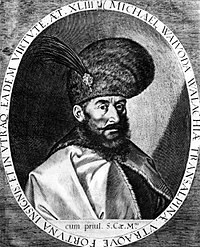 Portrait by Aegidus Sadeler (Prague, 1601) Portrait by Aegidus Sadeler (Prague, 1601) | |||||
| Reign | 11 October 1593 – 9 August 1601 | ||||
| Coronation | September, 1593 | ||||
| Predecessor | Alexandru cel Rău (Alexander the Evil One) | ||||
| Successor | Simion Movilă | ||||
| Burial | near present-day Câmpia Turzii, Transylvania | ||||
| Wife |
| ||||
| |||||
| Father | Pătraşcu cel Bun, Prince of Wallachia | ||||
| Mother | Teodora Cantacuzino | ||||
Michael the Brave (Template:Lang-ro, Template:Lang-hu, 1558 - August 9, 1601) was the Prince of Wallachia (1593–1601), of Transylvania (1599–1600), and of Moldavia (1600), the two Romanian principalities and Principality of Transylvania being joined under his reign for a short period of time.
During his reign, which coincided with the Long War, these three principalities forming the territory of present-day Romania and Republic of Moldova were ruled for the first time by a single Romanian leader, though the union lasted for less than six months. He is regarded as one of Romania's greatest national heroes.
His rule began in the autumn of 1593, and two years later the war with the Ottomans started, a conflict in which the Prince fought the Battle of Călugăreni, considered one of the most important battles of his reign. Although the Wallachians emerged victorious from the battle, Michael was forced to retreat with his troops and wait for aid from his allies (prince Sigismund Báthory of Transylvania, Emperor Rudolf II of Austria). The war continued until a peace finally emerged in January 1597, but this only lasted for a year and a half. Peace was again reached in late 1599, when Michael was unable to continue the war due to lack of support from his allies.
In 1599 Michael won the Battle of Şelimbăr and soon entered Alba Iulia, becoming the Prince of Transylvania. A few months later, Michael's troops invaded Moldavia and reached its capital, Suceava. The Moldavian leader Ieremia Movilă fled to Poland and Michael was declared Prince of Moldavia. Michael kept the control of all three provinces less than a year. The nobles of Transylvania rose against him along with, to a lesser extent, some boyars from Moldavia and Wallachia. Therefore, Michael allied with the Austrian General Giorgio Basta, defeated an uprising of the Hungarian nobility at Gurăslău in Transylvania. Immediately after this, Basta ordered the assassination of Michael, which took place on 9 August 1601.
Early life
He was born under the family name of Pătraşcu. In 1601, during a stay in Prague, he was portrayed by the painter Aegidius Sadeler, who mentioned on the portrait the words aetatis XLIII ("in the 43rd year of life"), which indicates as the year of Michael's birth the year 1558 Very little is known about his childhood and early years as an adult. He is argued by most historians to have been the illegitimate son of Wallachian Prince Pătraşcu cel Bun, while others believe he merely invented his descent in order to justify his rule. His mother was Teodora Cantacuzino, a member of the Cantacuzino family, an old boyar family of Wallachia and Moldavia, allegedly descended from the Byzantine Emperor John VI Cantacuzenus.Michael's political career was quite spectacular, as he became the Ban of Mehedinţi in 1588, stolnic at the court of Mihnea Turcitul by the end of 1588, and Ban of Craiova in 1593 - during the rule of Alexandru cel Rău. The latter had him swear before 12 boyars that he was not of princely descent. Still, in May 1593 conflict did break out between Alexandru and Michael who was forced to flee to Transylvania. He was accompanied by his half-brother Radu Florescu, Radu Buzescu and several other supporters. After spending two weeks at the court of Sigismund Báthory he left for Constantinople, where with help from his cousin Andronic Cantacuzino and Patriarch Jeremiah II he negotiated Ottoman support for his accession to the Wallachian throne. He was supported by the English ambassador in the Ottoman capital, Edward Barton, and aided by a loan of 200,000 florins. Michael was invested Prince by the Sultan in September 1593 and started his effective rule on October 11.
Wallachia
Not long after he became Prince of Wallachia, Michael turned against the Ottoman Empire. The next year he joined the Christian alliance of European powers formed by Pope Clement VIII, against the Turks, and signed treaties with his neighbours: Sigismund Báthory of Transylvania, Aron Tiranul of Moldavia and the Holy Roman Emperor, Rudolf II. He started a campaign against the Turks in the autumn of 1594, conquering several citadels near the Danube, including Giurgiu, Brăila, Hârşova, and Silistra, while his Moldavian allies defeated the Turks in Iaşi and other parts of Moldova. Mihai continued his attacks deep within the Ottoman Empire, taking the forts of Nicopolis, Ribnic, and Chilia and even reaching as far as Adrianople. At one point his forces were only 24 kilometers from Constantinople.

In 1595 Sigismund Báthory staged an elaborate plot and had Aron of Moldavia removed from power. Ştefan Josica (Báthory's chancellor and an ethnic Romanian) masterminded the operation. Ştefan Răzvan arrested Aron on alleged treason charges on the night of April 24 (May 5) and sent him to Alba Iulia (Gyulafehérvár) with his family and treasure. Aron would die poisoned by the end of May in the castle of Vint. Báthory was forced to justify his actions before the European powers, since Aron had actively joined the anti-Ottoman coalition. Later on, in the same city of Alba Iulia, Wallachian boyars signed a treaty with Sigismund on Michael's behalf. From the point of view of Wallachian internal politics, the Treaty of Alba Iulia officialized what could be called a boyar regime, reinforcing the already important political power of the noble elite. According to the treaty, a council of 12 great boyars was to take part alongside the voivode in the executive rule of the country.
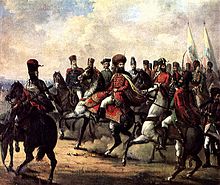
Boyars could no longer be executed without the knowledge and approval of the Transylvanian Prince and if convicted for treason their fortunes could no longer be confiscated. Apparently Michael was displeased with the final form of the treaty negotiated by his envoys but had to comply. Prince Michael said in a conversation with the Polish envoy Lubieniecki: ... they did not proceed as stated in their instructions but as their own good required and obtained privileges for themselves. He would try to avoid the obligations imposed on him for the rest of his reign.

During his reign, Michael relied heavily on the loyalty and support of a group of west-Wallachian lords, the most important were Buzescu Brothers (Fraţii Buzești) and on his own relatives on his mother's side, the Cantacuzinos. He consequently protected their interests throughout his reign; for example, he passed a law binding serfs to lands owned by aristocrats. From the standpoint of religious jurisdiction, the Treaty of Alba Iulia had another important consequence, as it placed all the Eastern Orthodox bishops in Transylvania under the jurisdiction of the Metropolitan Seat of Târgovişte.
During this period the Ottoman army, based in Ruse, was preparing to cross the Danube and undertake a major attack. Michael was quickly forced to retreat and the Ottoman forces started to cross the Danube on August 4, 1595. As his army was outnumbered, Michael avoided to carry the battle in open field, and he decided to give battle on a marshy field, located near the village of Călugăreni, on the Neajlov river. The Battle of Călugăreni started on August 13, and Michael defeated the Ottoman army led by Sinan Pasha. Despite the victory, he retreated to his winter camp in Stoeneşti because he had too few troops to mount a full scale war against the remaining Ottoman forces. He subsequently joined forces with Sigismund Báthory's 40,000-man army (led by István Bocskay) and counterattacked the Ottomans, freeing the towns of Târgovişte (October 8), Bucharest (October 12) and Brăila, temporarily removing Wallachia from Ottoman rule.

The fight against the Ottomans continued in 1596, when Michael made several incursions south of the Danube at Vidin, Pleven, Nicopolis, and Babadag, where he was assisted by the local Bulgarians during the First Tarnovo Uprising.
During late 1596, Michael was faced with an unexpected attack from the Tatars, who had destroyed the towns of Bucharest and Buzău. By the time Michael gathered his army to counterattack the Tatars had speedily retreated and so no battle was fought. Michael was determined to continue the war against the Ottomans, but he was prevented because he lacked support from Sigismund Báthory and Rudolf II. On January 7, 1597, Hasan Pasha declared the independence of Wallachia under Michael's rule, but Michael knew that this was only an attempt to divert him from preparing for another future attack. Michael again requested Rudolf II's support and Rudolf finally agreed to send financial assistance to the Wallachian ruler. On June 9, 1598, a formal treaty was reached between Michael and Rudolf II. According to the treaty, the Austrian ruler would give Wallachia sufficient money to maintain a 5,000-man army, as well as armaments and supplies. Shortly after the treaty was signed, the war with the Ottomans resumed and Michael besieged Nicopolis on September 10, 1598 and took control of Vidin. The war with the Ottomans continued until June 26, 1599, when Michael, lacking the resources and support to continue prosecuting the war, signed a peace treaty.
Transylvania
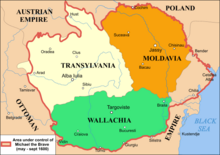
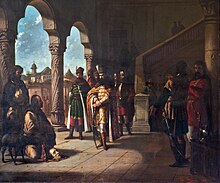

In April 1598 Sigismund resigned as Prince of Transylvania in favor of the Holy Roman Emperor, Rudolf II (who was also the King of Hungary), reversed his decision in October 1598, and then resigned again in favor of Cardinal Andrew Báthory, his cousin. Báthory was close to the Polish chancellor and hetman Jan Zamoyski and placed Transylvania under the influence of the King of Poland, Sigismund III Vasa. He was also a trusted ally of the new Moldavian Prince Ieremia Movilă, one of Michael's greatest enemies. Movilă had deposed Ştefan Rǎzvan with the help of Polish hetman Jan Zamoyski in August 1595.

Having to face this new threat, Michael asked Emperor Rudolf to become the sovereign of Wallachia. On September 25 (October 5) Báthory issued an ultimatum demanding that Michael abandon his throne. Michael decided to attack Báthory immediately to prevent invasion. He would later describe the events:
I rose with my country, my children, taking my wife and everything I had and with my army so that the foe should not crush me here.
He left Târgovişte on October 2 and by October 9 he reached Prejmer in Southern Transylvania, where he met envoys from the city of Braşov. Sparing the city, he moved on to Cârţa where he joined forces with the Székelys.
On October 18, Michael won a decisive victory against the army of prince-cardinal Andrew Báthory at the Battle of Şelimbăr, giving him control of Transylvania. Báthory was killed by anti-Báthory Székely on 3 November shortly after the battle, dying at the age of 38, and Michael gave him a princely burial in the Roman Catholic Cathedral of Alba Iulia. With his enemy dead, Michael entered the Transylvanian capital at Alba Iulia, and received the keys to the fortress from Bishop Demeter Napragy, later depicted as a seminal event in Romanian historiography. Stephen Szamosközy, keeper of the Archives at the time, recorded the event in great detail. He also wrote that two days before the Diet met on October 10, Transylvanian nobles elected Michael the voivode as Prince of Transylvania. As the Diet was assembled, Michael demanded that the estates swear loyalty to Emperor Rudolf, then to himself and thirdly to his son.
Even if he was recognized by the Transylvanian parliament (diet) only as imperial governor subject to the Holy Roman Emperor, however, he was de facto ruler of Transylvania.
Michael used in Transylvania the following signature on official documents: Michael Valachiae Transalpinae Woivoda, Sacrae Caesareae Regiae Majestatis Consiliarius per Transylvaniam Locumtenens, cis transylvaniam partium eius super exercitu Generalis Capitaneus". ("Michael, voivode of Wallachia, the councillor of His Majesty the Emperor and the King, his deputy in Transylvania and General Captain of his troops from Transylvania.")
When Michael entered Transylvania, he did not free or grant rights to the Romanian inhabitants, who were primarily peasants but, nevertheless, constituted 50% of the population. Instead he sought to support the Hungarian, Szekler, and Saxon nobles by reaffirming their rights and privileges.
There is no evidence that Michael wanted Transylvania's Romanians to play a political role. Indeed, while he brought some of his Wallachian aides to Transylvania, he also invited some Székelys and other Transylvanian Hungarians to assist in the administration of Wallachia, where he wished to transplant Transylvania's far more advanced feudal system.
Michael began negotiating with the Emperor over his official position in Transylvania. The latter wanted the principality under direct Imperial rule with Michael acting as governor. The Wallachian voivode, on the other hand, wanted the title of Prince of Transylvania for himself and equally claimed the Partium region. Michael was, nevertheless, willing to acknowledge Habsburg overlordship.
Moldavia

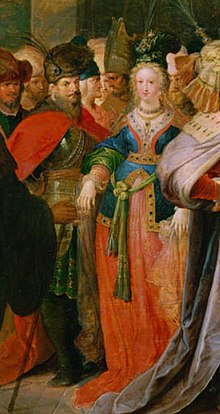
The Moldavian Prince Ieremia Movilă had been an old enemy of Michael, having incited Andrew Báthory to send Michael the ultimatum demanding his abdication. His brother, Simion Movilă, claimed the Wallachian throne for himself and had used the title of Voivode since 1595. Aware of the threat the Movilas represented, Michael had created the Banat of Buzău and Brăila in July 1598 and the new Ban was charged of keeping an alert eye on Moldavian, Tatar and Cossack moves, although Michael had been planning a Moldavian campaign for several years.
On February 28, Michael met with Polish envoys in Braşov. He was willing to recognise the Polish King as his sovereign in exchange for the crown of Moldavia and the recognition of his male heirs' hereditary right over the three principalities, Transylvania, Moldavia and Wallachia. This did not significantly delay his attack however, on April 14, 1600 Michael's troops entered Moldavia on multiple routes, the Prince himself leading the main thrust to Trotuş and Roman. He reached the capital of Suceava on May 6. The garrison surrendered the citadel the next day and Michael's forces caught up with the fleeing Ieremia Movilă, who was only saved from being captured by the sacrifice of his rear-guard. Movilă took refuge in the castle of Khotyn together with his family, a handful of faithful boyars and the former Transylvanian Prince, Sigismund Báthory. The Moldavian soldiers in the castle deserted, leaving a small Polish contingent as sole defenders. Under the cover of dark, sometime before June 11, Movilă managed to sneak out of the walls and across the Dniester to hetman Stanisław Żółkiewski's camp.
Neighboring states were alarmed by this upsetting of the balance of power, especially the Hungarian nobility in Transylvania, who rose against Michael in rebellion. With the help of Basta, they defeated Michael at the Battle of Mirăslău, forcing the prince to leave Transylvania together with his remaining loyal troops. A Polish army led by Jan Zamoyski drove the Wallachians from Moldavia and defeated Michael at Năieni, Ceptura, and Bucov (Battle of the Teleajăn River). The Polish army also entered eastern Wallachia and established Simion Movilă as ruler. Forces loyal to Michael remained only in Oltenia.
Last victory and the assassination

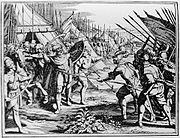
Michael asked again for assistance from emperor Rudolf during a visit in Prague between February 23 and March 5, 1601, which was granted when the emperor heard that General Giorgio Basta had lost control of Transylvania to the Hungarian nobility led by Sigismund Báthory, who accepted the Ottoman protection. Meanwhile, forces loyal to Michael in Wallachia led by his son, Nicolae Pătraşcu, drove out Simion Movilă from Moldova and prepared to reenter Transylvania. Michael, allied with Basta, defeated the Hungarian army in Battle of Guruslău. A few days later Basta, who was looking for Transylvania control, ordered the assassination of Michael, which took place near Câmpia Turzii on 9 August 1601. According to Romanian historian Constantin C. Giurescu:
Never in Romanian history was a moment of such highness glory so closely followed by bitter failure.
Seal of Michael the Brave

The seal comprises the coats of arms of the three Romanian principalities: in the middle, on a shield the Moldavian urus, above Wallachian eagle between sun and moon holding cross in beak, below Transylvanian coat of arms: two meeting, standing lions supporting a sword, treading on seven mountains. The Moldavian shield is held by two crowned figures.
There are two inscriptions on the seal. First, circular, in Cyrillic Old Bulgarian "IO MIHAILI UGROVLAHISCOI VOEVOD ARDILSCOI MOLD ZEMLI", meaning "Io Michael Voivode of Wallachia, Transylvania and Moldavia Land". Second, placed along a circular arc separating the Wallachian coat from the rest of the heraldic composition, "NML BJE MLRDIE", could be translated "Through The Very Grace of God".
Legacy

Michael the Brave's rule, with its break with Ottoman rule, tense relations with other European powers and the union of the three states, was considered in later periods as the precursor of a modern Romania, a thesis which was argued with noted intensity by Nicolae Bălcescu. This theory became a point of reference for nationalists, as well as a catalyst for various Romanian forces to achieve a single Romanian state.
The prince, who managed for a short time (1599–1600) to rule the three territories that were to be united some three centuries later in modem Romania, begins to be perceived as a unifier only towards the middle of the 19th century. Such an interpretation is completely lacking in the historiography of the 17th century chroniclers, and even in that of the Transylvanian School around 1800. What they emphasized, apart from the exceptional personality of Michael himself, were the idea of Christendom and his close relations with Emperor Rudolf. The conqueror's ambition is likewise frequently cited as a motivation for his action, occupying in the interpretative schema the place which was later to be occupied by the Romanian idea.
In the writings of the Moldavian chronicler Miron Costin, Michael the Brave appears in the role of conqueror of Transylvania and Moldavia, "the cause of much spilling of blood among Christians", and not even highly appreciated by his own Wallachians: "The Wallachians became tired of the warful rule of Voivode Mihai"
The perspective of the Wallachians themselves is to be found in The History of the Princes of Wallachia, attributed to the chronicler Radu Popescu (1655–1729), which bundles together all Michael's adversaries without distinction. Romanians and foreigners alike: "He subjected the Turks, the Moldavians, and the Hungarians to his rule, as if they were his asses.". The picturesque flavor of the expression only serves to confirm the absence of any Romanian idea
Samuil Micu, a member of the Transylvanian School said in his work Short Explanation of the History of the Romanians (written in the 1790s): "In the year 1593, Michael, who is called the Brave, succeeded to the lordship of Wallachia. He was a great warrior, who fought the Turks and defeated the Transylvanians. And he took Transylvania and gave it to Emperor Rudolf"
Mihai Viteazul, a commune in Cluj County, was named after Michael the Brave. Michael is also commemorated by the monks of the Athonite Simonopetra Monastery for his great contributions in the form of land and money to rebuilding the monastery which had been destroyed by a fire.
Mihai Viteazul, a film by Sergiu Nicolaescu, a famous Romanian film director, is a representation of the life of the Wallachian ruler, and his will to unite the three Romanian principalities (Wallachia, Moldavia, and Transylvania) in one country.
The Order of Michael the Brave, Romania's highest military decoration, was named after Michael.
Notes
Wallachia and Moldavia were ethinc pure Romanian countries, while Transylvania had a mixed population, with Romanians being the majority.
- Giurescu, p. 180.; Iorga.
- Panaitescu.
- According to the XVIIIth century chronicle of Radu Popescu.
- http://www.1911encyclopedia.org/Rumania
- Giurescu, p. 182.
- Giurescu, p. 183.
- Coln, Emporungen so sich in Konigereich Ungarn, auch in Siebenburgen Moldau, in der der bergischen Walachay und anderen Oerten zugetragen haben, 1596
- Marco Venier, correspondance with the Doge of Venice, 16 July 1595
- C. Rezachevici - "Legenda şi substratul ei istoric"
- ^ Giurescu, p. 186.
- Manea.
- Panaitescu; Bolovan.
- Giurescu, p. 189.
- Giurescu, p. 190.
- Giurescu, p. 191.
- ^ Giurescu, p. 193.
- Giurescu, p. 192.
- ^ Giurescu, p. 194.
- Helen Matau Powell. Matau Family History & Related Lineages: With a Brief History of Romania. University of Wisconsin - Madison, Gateway Press, 2002.
- Giurescu, p. 195.
- Giurescu, p. 196.
- History of Transylvania by Akadémiai Kiadó
- George W. White, Nationalism and territory, 2000, p.132
- Giurescu, p. 196–97.
- ^ Giurescu, p. 198.
- ^ Giurescu, p. 199.
- Giurescu, p. 201.
- ^ Giurescu, p. 200.
- Giurescu, p. 201–05.
- Homutescu.
- Giurescu, p. 211–13.
- Original text: "Sa urise muntenilor cu domniia lui Mihai-voda,totii cu osti si razboaie." (Romanian) http://www.scribd.com/doc/43781/Miron-Costin-Letopiseul-rii-Moldovei
- History and myth in Romanian consciousness , byLucian Boia http://books.google.ro/books?id=RM6MRPWXxQYC&pg=PP1&dq=History+and+myth+in+Romanian+consciousness++De+Lucian+Boia&cd=1#v=onepage&q=&f=false
- Ordinul Mihai Viteazul, ww2awards.com, Retrieved 10 April 2008
References
- Bolovan, Ioan (1997). A History of Romania (3rd ed.). Iași: Center for Romanian Studies. ISBN 9789739809108. OCLC 39225262.
{{cite book}}: Unknown parameter|coauthors=ignored (|author=suggested) (help) - Giurescu, Constantin C. (2007) . Istoria Românilor. Bucharest: Editura All.
{{cite book}}: Cite has empty unknown parameter:|coauthors=(help) Template:Ro icon - Homutescu, Adrian. "Elements of Romanian Heraldry". Archived from the original on 2008-03-23. Retrieved 2008-03-03.
- Ionaşcu, Ion (1962). "Mihai Viteazul şi autorii tratatului de la Alba Iulia (1595)". Anuarul Institutului de istorie şi arheologie, Cluj-Napoca. 5. Cluj-Napoca: Editura Academiei R.S.R.: 111–44. ISSN 0253-1550. OCLC 20377434. Template:Ro icon
- Iorga, Nicolae (1904). Ștefan-cel-mare și Mihai-Viteazul: ca întemeietorii bisericii Românilor din Ardeal (pdf). Bucharest: Minerva. OCLC 18153903. Retrieved 2008-03-03. Template:Ro icon
- Iorga, Nicolae (1968). Istoria lui Mihai Viteazul. Bucharest: Editura Militară. OCLC 1243864. Template:Ro icon
- Manea, Cristina Anton (2003). "Structura şi restructurarea marii boierimi din Ţara Românească de la începutul secolului al XVI-LEA până la mijlocul secolului al XVII-LEA". Archived from the original (PhD. Thesis) on February 8, 2008. Retrieved 2008-03-03.
{{cite journal}}: Cite journal requires|journal=(help) Template:Ro icon - Panaitescu, Petre P. (1936). Mihai Viteazul. Bucharest: Fundaţia Regală. OCLC 29925825. Template:Ro icon
- Rezachevici, Constantin (1999). "Mihail Viteazul: Cele patru itinerarii transilvane". Magazin istoric. ISSN 0541-881X. OCLC 2263749. Archived from the original on October 10, 2007. Retrieved 2008-03-03.
{{cite journal}}: Unknown parameter|month=ignored (help) Template:Ro icon - Rezachevici, Constantin (2000). "Mihail Viteazul: Itinerariul moldovean". Magazin istoric. ISSN 0541-881X. OCLC 2263749. Archived from the original on September 26, 2007. Retrieved 2008-03-03.
{{cite journal}}: Unknown parameter|month=ignored (help) Template:Ro icon - Rezachevici, Constantin (2000). "Legenda şi substratul ei istoric. Mihail Viteazul Restituror Daciae?". Magazin istoric. ISSN 0541-881X. OCLC 2263749. Archived from the original on December 22, 2007. Retrieved 2008-03-03.
{{cite journal}}: Unknown parameter|month=ignored (help) Template:Ro icon
| Mihai I of WallachiaHouse of Basarab Drăculeşti branch Died: 1601 9 August | ||
| Regnal titles | ||
|---|---|---|
| Preceded byAlexandru cel Rău | Prince of Wallachia 1593-1600 |
Succeeded bySimion Movilă |
| Preceded byAndrew | Prince of Transylvania 1599–1600 |
Succeeded byRudolf II |
| Preceded byIeremia Movilă | Prince of Moldavia 1600 |
Succeeded byIeremia Movilă |
| Notes and references | ||
| 1. Regnal Chronologies | ||
Categories: